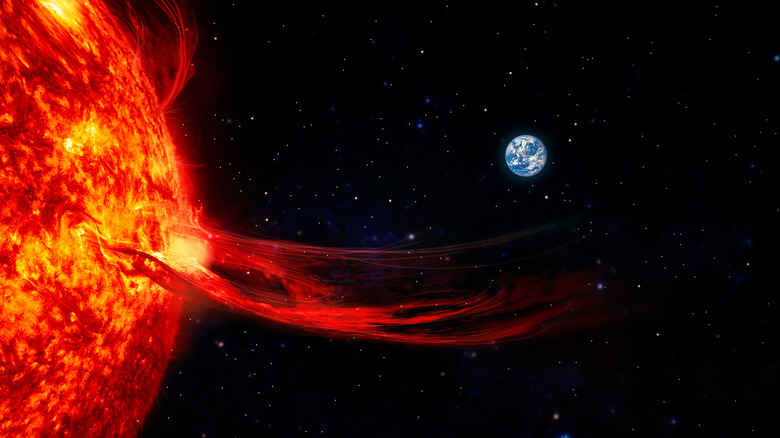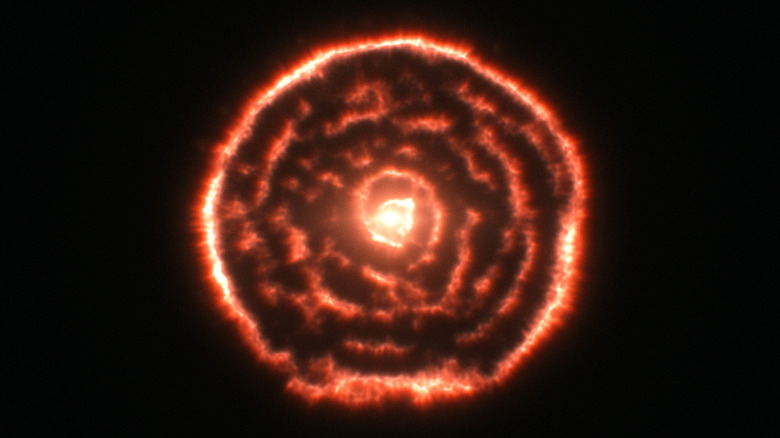Why Some Scientists Are Suggesting The Sun Might End Life One Day
How and when will the world end? It's a question that has long troubled scientists, philosophers, and anyone with a bit of an existential crisis. While the short answer is, we don't really know, that hasn't stopped many researchers, scientists, astronomers, and countless others from theorizing about the many possible ways the world could ultimately meet its demise. And it might not come as a surprise to know that quite a few of these theories involve our closest star, the sun.
As most of us probably already know, we are dependent on the sun for our very survival. Sitting 93 million miles away, it provides just enough warmth and light to allow for life on Earth, without burning us to death in a fiery blaze. But all of that could one day change. In just an instant, a solar flare could emit a bright flash that would send an enormous amount of high-energy particles, with the explosive force of hundred of billions of tons of TNT, directly toward the Earth's surface. Luckily, the planet's magnetic field lines help protect us from the sun's radiation, which prevents our untimely death by solar flares, according to Universe Today. But that is far from the only way the sun can kill us all.
The sun will burn brighter and brighter
The sun can also be responsible in myriad ways for what scientists refer to as an "Extinction Level Event," a single massive catastrophe that would lead to the destruction of all or the great majority of life on Earth, per ThoughtCo. As one could probably imagine, the sun could be involved in a number of these events. One common theory is that one day, should we somehow manage to survive all the other types of apocalyptic events that could befall us, the sun will keep burning brighter and brighter until it kills us all.
To simply stay alive, the sun has to burn 600 million tons of hydrogen, which it converts into helium at its core, per Business Insider. This process causes the sun's core to contract, which in turns sparks a series of nuclear fusion reactions that increase the amount of energy the sun emits. Thus, the sun is always getting a little bit brighter and a little bit hotter. In another 1 billion years from now, the sun will be about 10% brighter than it is today, and in about 3.5 billion years, it will shine close to 40% brighter. By this point, scientists predict the temperatures on Earth will have risen to catastrophic levels, eventually causing the oceans to boil, ice caps to evaporate, and the surface of the planet to become far too hot and radioactive to sustain life, according to Universe Today.
The sun will become a red giant
This leaves just two likely scenarios: Either life on Earth will simply die because the sun will have evaporated all the water, leaving the planet dry, hot, and totally uninhabitable; or, in the off chance some life-forms survive that, the Earth will eventually be swallowed by the sun's expanding atmosphere as it starts burning helium instead of hydrogen. "Once hydrogen has stopped burning in the core of the sun, the star has formally left the main sequence and can be considered a red giant. It will then spend about a billion years expanding," Jillian Scudder, an astrophysicist at the University of Sussex, explained to Business Insider. Even in the extremely unlikely chance the planet escapes the reach of the growing red giant, all life would probably be burnt to a crisp since it will still be extremely close to the sun's surface.
All of this certainly sounds very frightening, but it is best not to worry too much. If it is any consolation, most scientists believe by the time these apocalyptic events occur, humanity will already have long since died out.


